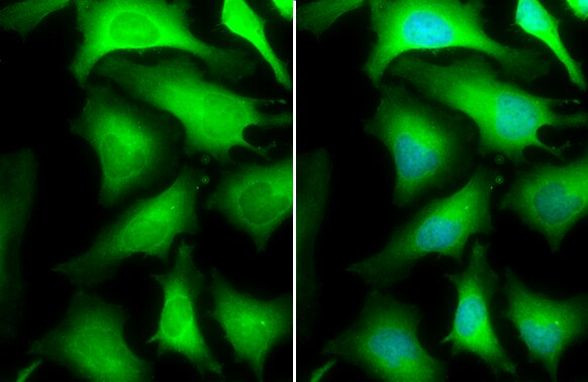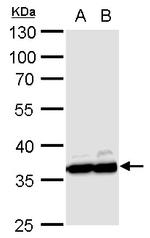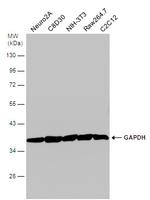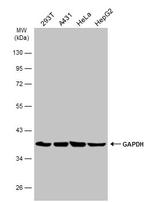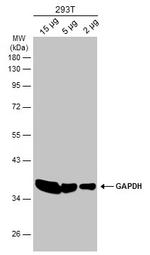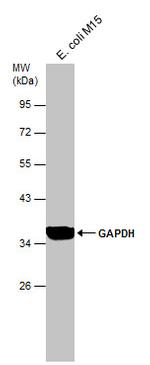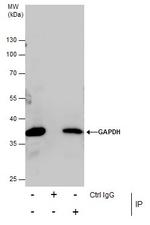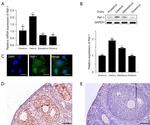Search Thermo Fisher Scientific
Invitrogen
GAPDH Polyclonal Antibody
Product Details
PA5-85074
Species Reactivity
Published species
Host/Isotype
Class
Type
Immunogen
Conjugate
Form
Concentration
Purification
Storage buffer
Contains
Storage conditions
Shipping conditions
RRID
Product Specific Information
Keep as concentrated solution.
Predicted reactivity: Mouse (94%), Rat (94%), Zebrafish (86%), Xenopus laevis (85%), Dog (95%), Cat (96%), Pig (95%), Rabbit (94%), Chicken (92%), Sheep (94%), Rhesus Monkey (99%), Bovine (94%), Guinea pig (94%).
Positive Control: 293T, A431, HeLa, HepG2, Neuro 2A, C8D30, NIH-3T3, Raw264.7, C2C12, PC-12, Rat2, E.coli M15, SH-SY5Y, A549, U2OS, H9C2, A7R5, mouse skin tissue.
Store product as a concentrated solution. Centrifuge briefly prior to opening the vial.
Target Information
GAPDH (Glyceraldehyde-3-phosphate dehydrogenase) is a catalytic enzyme commonly known to be involved in glycolysis. GAPDH exists as a tetramer of identical 37-kDa subunits and catalyzes the reversible reduction of 1,3-bisphosphoglycerate to glyceraldehyde 3-phosphophate in the presence of NADPH. Apart from playing a key role in glycolysis, GAPDH is ubiquitously expressed and displays other activities unrelated to its glycolytic function. GAPDH is reported to be involved in the processes of DNA replication, DNA repair, nuclear RNA export, membrane fusion and microtubule bundling. Studies provide evidence of GAPDH playing an essential part in gene expression observed in apoptosis and as part of the cellular phenotype of age-related neurodegenerative diseases. Further, GAPDH is involved in other cellular processes ranging from membrane fusion, and neuronal apoptosis in cancer. GAPDH is reported to bind to a variety of other proteins, including the amyloid precursor protein, mutations in which cause some forms of Alzheimer's disease (AD), and the polyglutamine tracts of Huntingtin, the protein product aberrant forms of which are causative of Huntington's disease. Associations between GAPDH, actin and tubulin have also be reported. Since GAPDH is expressed at high levels in most tissues, it is useful as protein loading control in Western Blot analysis.
For Research Use Only. Not for use in diagnostic procedures. Not for resale without express authorization.
Bioinformatics
Protein Aliases: 38 kDa BFA-dependent ADP-ribosylation substrate; aging-associated gene 9 protein; BARS-38; EC 1.2.1.12; epididymis secretory protein Li 278; epididymis secretory sperm binding protein Li 162eP; GAPD; GAPDH; GAPDH-2; glyceraldehyde 3-phosphate dehydrogenase, testis-specific; glyceraldehyde phosphate dehydrogenase; Glyceraldehyde-3-phosphate dehydrogenase; Glyceraldehyde-3-phosphate dehydrogenase 2; glyceraldehyde-3-phosphate dehydrogenase type 2; glyceraldehyde-3-phosphate dehydrogenase, spermatogenic; Glyceraldehyde-3-phosphate dehydrogenase, testis-specific; HGNC:4141; MGC88685; Peptidyl-cysteine S-nitrosylase GAPDH; Spermatogenic cell-specific glyceraldehyde 3-phosphate dehydrogenase 2; Spermatogenic glyceraldehyde-3-phosphate dehydrogenase; unnamed protein product
Gene Aliases: BARS-38; bb02e05; cb350; cb609; CDABP0047; fb71f08; fk58c09; G3PD; g3pdh; GAPD; Gapd-s; GAPD2; GAPDH; GAPDH-2; GAPDH2; GAPDHS; GAPDS; HEL-S-162eP; HEL-S-278; HSD-35; HSD35; I79_001391; mg:bb02e05; OK/SW-cl.12; wu:fb33a10; wu:fb71f08; wu:fk58c09; wu:ft80f05; zgc:76908
UniProt ID: (Rabbit) P46406, (Human) P04406, (Pig) P00355, (Bovine) P10096, (Human) O14556, (Bovine) Q2KJE5, (Mouse) P16858, (Chinese hamster) P17244, (Rat) P04797, (Rat) Q9ESV6, (Mouse) Q64467, (Zebrafish) Q5XJ10, (Zebrafish) Q5MJ86
Entrez Gene ID: (Rabbit) 100009074, (Human) 2597, (Pig) 396823, (Dog) 403755, (Bovine) 281181, (Human) 26330, (Dog) 476483, (Pig) 100517097, (Bovine) 532231, (Rabbit) 100352213, (Mouse) 14433, (Chinese hamster) 100736557, (Rat) 24383, (Chinese hamster) 100767862, (Rat) 66020, (Mouse) 14447, (Zebrafish) 317743, (Zebrafish) 406367

Performance Guarantee
If an Invitrogen™ antibody doesn't perform as described on our website or datasheet,we'll replace the product at no cost to you, or provide you with a credit for a future purchase.*
Learn more
We're here to help
Get expert recommendations for common problems or connect directly with an on staff expert for technical assistance related to applications, equipment and general product use.
Contact tech support
